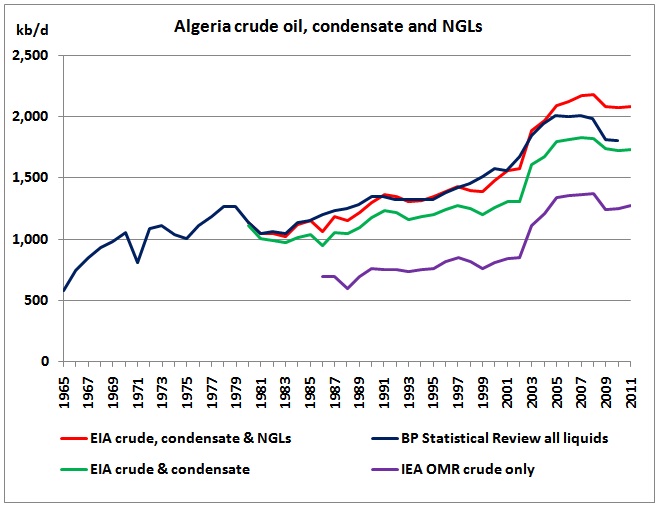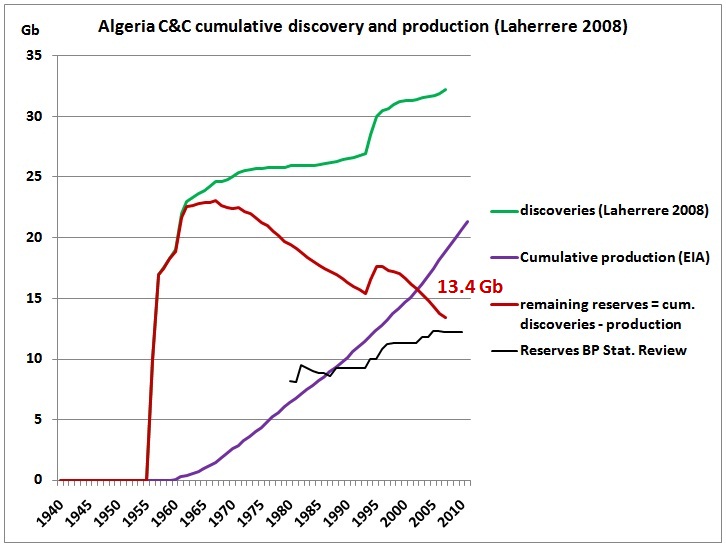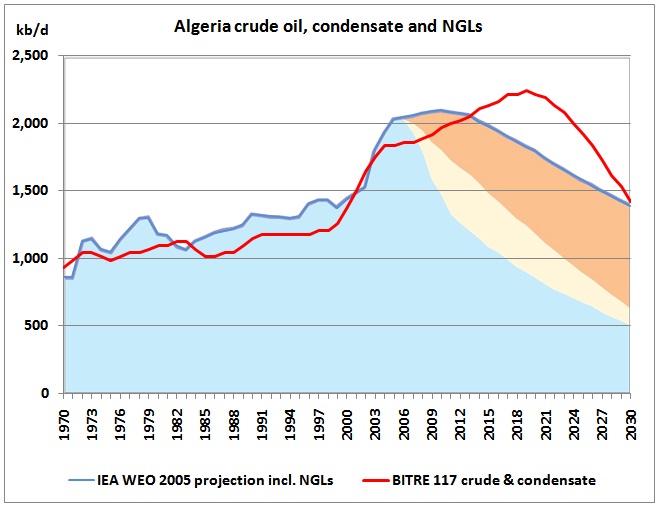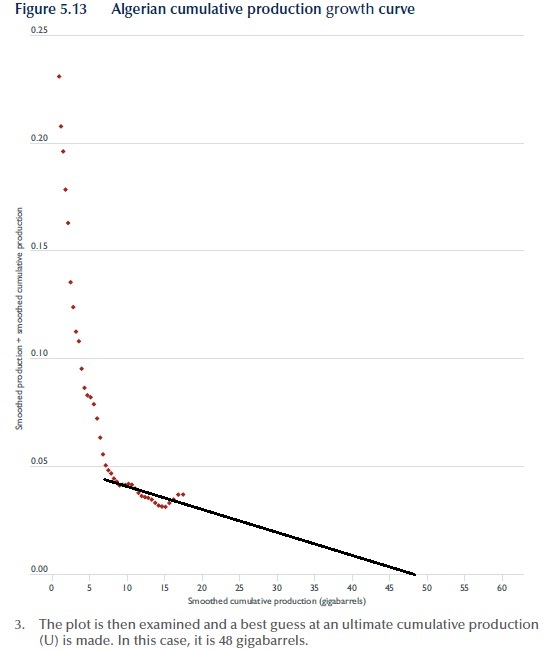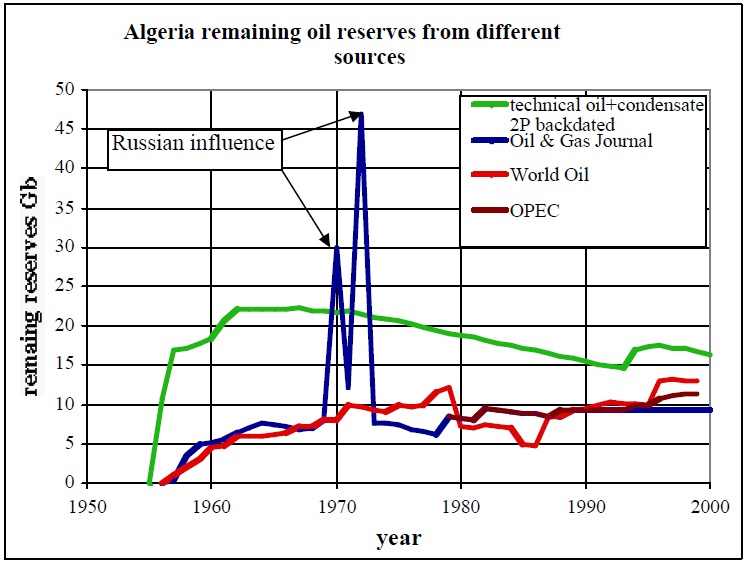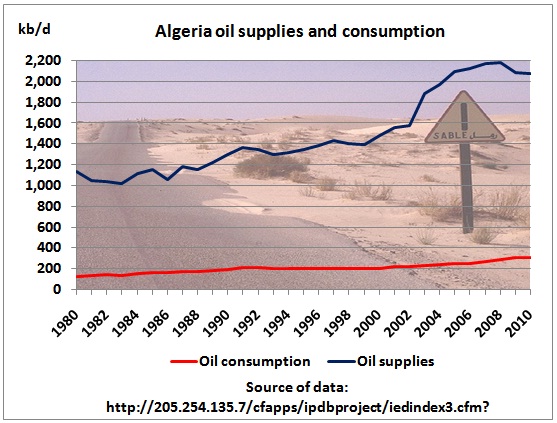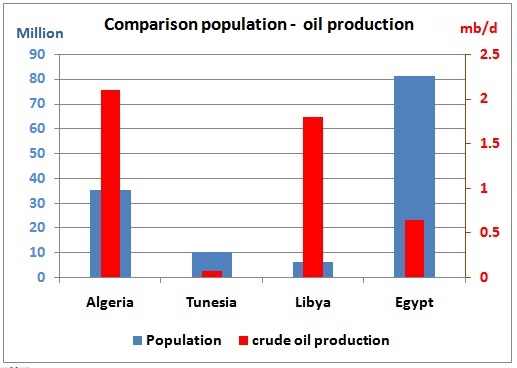(1) Actual production
We have 3 components of oil supplies from different sources:
crude oil only (statistics from IEA)
condensate (statistics from EIA)
natural gas liquids (statistics from EIA)
Note that oil production in the BP Statistical Review (which contains all liquids) is lower in the last years than that of the EIA. The graph suggests a peak in 2007/2008.
(2) Comparison with IEA WEO 2005
The focus of the IEA World Energy Outlook 2005 was on oil production in MENA countries, also Algeria. It contained on page 297 this production profile for oil including condensate and NGLs, declining at 1.5% pa after 2011:
 http://www.iea.org/weo/docs/weo2005/WEO2005.pdf
http://www.iea.org/weo/docs/weo2005/WEO2005.pdf
Let us superimpose on this graph the actual production data from the EIA, IEA and BP Statistical Review.
The IEA estimated a flat production peak between 2008 and 2012. The EIA curve (red) comes quite close to this. Now the IEA is not known for pessimistic outlooks but their estimate is 6 years old so we need to look for more recent reports
(3) IEA Oil Market Reports
From the IEA Monthly Oil Market Report 6/2010, page 19
Algeria’s production capacity has stagnated at around 1.4 mb/d since 2006 and is on course to decline this year and next, largely due to unattractive contract terms for foreign companies. Yousfi [new Oil Minister replacing Khelil] therefore inherits a national oil industry in decline, beset by chronic bureaucracy and infighting for political control over setting the country’s energy strategy.
From the IEA Monthly Oil Market Report 12/2010, page 24
Algeria’s production capacity has also been scaled back from the June forecast, with capacity now largely expected to remain unchanged over the 2009‐15 period, at around 1.37 mb/d. The 65 kb/d downward revision from June is due in part to the unexpected, lengthy paralysis at the top management level following the massive corruption scandal that swept through the state oil company at the beginning of 2010. Bureaucratic delays apparently worsened over the year as new management reviewed contracts already awarded which, in turn, has stalled development timelines. In addition, existing unattractive contract terms for technically challenging EOR projects continue to derail capacity expansion plans. With the dust from the scandal still settling it is unclear if Algeria will resume its plans to increase capacity or hold it flat and focus solely on its gas industry.
So the blame for stagnating oil production is put on an inefficient government. We need more evidence for peak oil in Algeria.
(4) Discoveries, production and depletion levels
We update cumulative crude and condensate production in Jean Laherrere’s 2008 presentation by ASPO France in 5/ 2009
http://aspofrance.viabloga.com/texts/documents

by extending the cumulative production curve and we get a depletion level of 61% in 2011
 Adopted from: Creaming curves & cumulative discovery at end 2007 for African countries
Adopted from: Creaming curves & cumulative discovery at end 2007 for African countries
http://aspofrance.viabloga.com/files/JL_Africacream_2009.pdf
We draw the remaining reserve curve and find the depletion midpoint (intersection with cumulative production) was already in 2002.
The remaining reserves end 2007 were 13.4 Gb compared to 12.2 Gb in the BP Statistical Review. Note, however, that the “political” reserves in the BP review give a completely wrong picture of the reserve history.
Other reserve estimates:
In
PFC Energy’s Global Crude Oil
and Natural Gas Liquids Supply Forecast
September 2004
this graph was shown with depletion levels in various OPEC countries:
 http://www.ecolo.org/documents/documents_in_english/oil-forecasts-04.pdf
http://www.ecolo.org/documents/documents_in_english/oil-forecasts-04.pdf
Algeria had a depletion level of 50% end 2003 (Laherrere 46%)
The ASPO newsletter #46 (October 2004) compared PFC’s reserve estimate with others in this table:
 http://www.energybulletin.net/node/2390
http://www.energybulletin.net/node/2390
Compare the remaining reserves in this table with Jean’s 15.3 Gb end 2003 and that tells us that he is not “pessimistic”.
(5) Production outlook
Jean was so kind to send me an update of his data with a slightly reduced ultimate of 33 Gb.
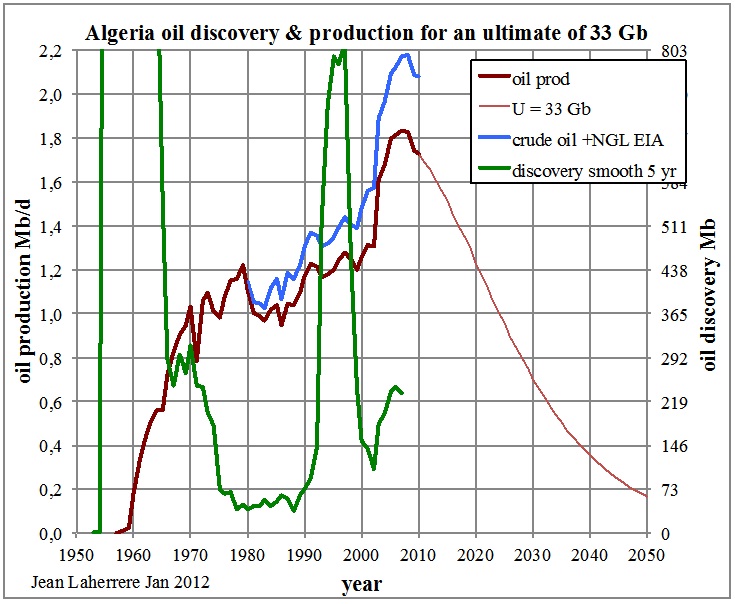 Oil production stands for crude and condensate. Jean has used a logistic curve
Oil production stands for crude and condensate. Jean has used a logistic curve
http://www.peak-oil-news.info/hubbert-logistic-curve/
to forecast future production for an ultimate of 33 Gb in 2100. Of importance to us right now is the decline rate until 2020 and that is (1.25 / 1.8 – 1)/12 years = -2.5 % pa.
The IEA WEO has for oil including NGLs a decline rate of (1.8/2.1 -1)/11 years = 1.3%
(6) Comparison with BITRE 117
This report contains a production profile for Algeria in the Africa graph and table 5.3, page 109
We use these data and superimpose them on the IEA WEO 2005
We can clearly see the BITRE 117 lifts production up to new heights by the end of the decade. The reason for this is that BITRE assumes 48 Gb as the ultimate reserve compared to 32.5 Gb in the WEO 2005 (Table 9.6) – but that includes NGLs.
BITRE 117 arrived at 48 Gb by drawing a trend line (added by author) in the graph production/cumulative production vs. cumulative production, a method usually called the Hubbert linearization method:
What has been overlooked, however, is that there are 2 distinctive discovery/production cycles. The 2nd cycle brought an additional 5 Gb. So these 2 cycles should have been modelled separately. This should have been known to BITRE as Jean Laherrere wrote in a 2001 paper: “Two supergiants were found (I participated in the discovery) in the 50s: Hassi Messaoud (10 Gb) and Hassi R’Mel (100 Tcf), but a new cycle reappears in the 90s in the Berkine area. It has to be noticed that around 1970 (because of the Russian influence?), reserves were boosted to high values reported by OGJ to drop quickly back to normal.”
http://www.iiasa.ac.at/Research/ECS/IEW2001/pdffiles/Papers/Laherrere-long.pdf
(7) Export Land Model
Oil consumption, now around 300 kb/d, has been growing by 50% in 10 years, albeit from a low base. Population, currently 35 million, is growing at 2.6% pa:
Looking at the ratios oil production to population for the 4 neighbouring countries we see that Algeria is much better off than Tunesia and Egypt but worse off than Libya with a very low population.
Algeria’s oil exports will shrink. By 2020, crude and NGL production could be as low 1. 6 mb/d (1.2 mb/d crude and 400 kb/d NGLs). If consumption grows as in the past 10 years – to 400 kb/d – exports would then only be around 1.2 mb/, down from 1.7 mb/d now.
 2009 exports went to following countries:
2009 exports went to following countries: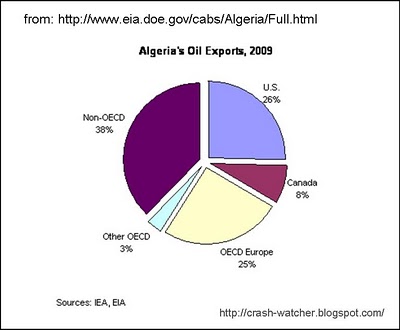
(8) IMF: break-even oil price $88 for balanced budget
Extracts from the IMF website:
IMF Survey online: Could you paint a picture of Algeria’s economy today?
Toujas-Bernaté: Demographic trends have played an important role. The Algerian population is young and rapidly growing, so Algeria needs much higher growth to be able to absorb new entrants in the labor market. As indicated by the analysis of others like the World Bank, there is the issue of labor market rigidity—it’s costly and difficult to hire and fire people—and there is also a skills mismatch between the demand and supply of labor. I should stress that Algeria has come a long way—a decade ago, youth unemployment exceeded 50 percent. Nevertheless, 21 percent unemployment among the young today remains very high.
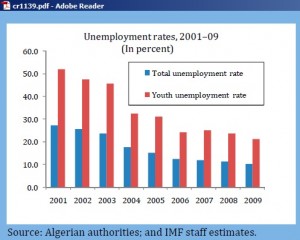 IMF Survey online: Youth unemployment now exceeds 20 percent in Algeria. Why?
IMF Survey online: Youth unemployment now exceeds 20 percent in Algeria. Why?
Toujas-Bernaté: Demographic trends have played an important role. The Algerian population is young and rapidly growing, so Algeria needs much higher growth to be able to absorb new entrants in the labor market. As indicated by the analysis of others like the World Bank, there is the issue of labor market rigidity—it’s costly and difficult to hire and fire people—and there is also a skills mismatch between the demand and supply of labor. I should stress that Algeria has come a long way—a decade ago, youth unemployment exceeded 50 percent. Nevertheless, 21 percent unemployment among the young today remains very high.http://www.imf.org/external/pubs/ft/survey/so/2011/int012611a.htm
From the 2011 staff report:
 “The budget will remain in deficit despite the rise in hydrocarbon revenues. Algeria is expected to post in 2010 its second consecutive budget deficit of the decade, which could reach 4 percent of GDP following a deficit of about 7 percent in 2009. The increase in hydrocarbon revenues will be more than offset by a 17 percent increase in total expenditures. Reflecting the substantial increase in expenditures in recent years, the breakeven oil price that would correspond to a balanced budget increased from US$34/bbl in 2005 to US$88/bbl in 2010. A reform of civil service wages and salaries, to rationalize their structure, has led to a 34 percent rise in the wage bill with effect from 2008. As a result, current expenditure is projected to grow by 31 percent (including salary back payments for 2008–09 in the education sector).
“The budget will remain in deficit despite the rise in hydrocarbon revenues. Algeria is expected to post in 2010 its second consecutive budget deficit of the decade, which could reach 4 percent of GDP following a deficit of about 7 percent in 2009. The increase in hydrocarbon revenues will be more than offset by a 17 percent increase in total expenditures. Reflecting the substantial increase in expenditures in recent years, the breakeven oil price that would correspond to a balanced budget increased from US$34/bbl in 2005 to US$88/bbl in 2010. A reform of civil service wages and salaries, to rationalize their structure, has led to a 34 percent rise in the wage bill with effect from 2008. As a result, current expenditure is projected to grow by 31 percent (including salary back payments for 2008–09 in the education sector).
http://www.imf.org/external/pubs/ft/scr/2011/cr1139.pdf
Conclusion:
In order to offset declining oil exports between 20% and 30% by 2020 Algeria would need correspondingly increasing oil prices to balance its budget.
Oil and gas map from the IEA WEO 2005
